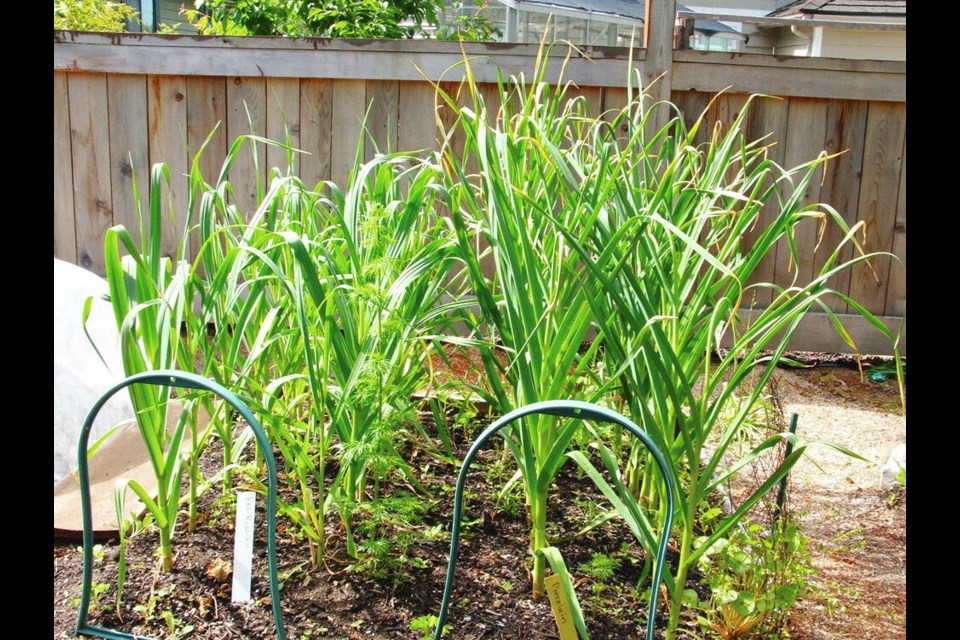Dear Helen: My garlic bulbs were smaller than usual this year. I’ve heard from other gardeners who have experienced the same disappointment. I’m also wondering about the best conditions for “curing” the bulbs in preparation for storing them.
J.O.
My garlic bulbs were small, too. Even some growers with decades of experience growing garlic produced small bulbs this year.
Last year, the cool, damp weather that lasted through late spring followed by a warm summer and early autumn produced large bulbs that cured and stored wonderfully. I was still using last year’s garlic into July this year.
With this year’s early, intense heat, the longstanding routine spring care of garlic plantings did not work well. Garlic has long been considered a productive, low-maintenance crop. Plant in the cool, moist conditions of autumn and that’s pretty much it, apart from weeding, until the plants have half-dried and the bulbs are harvested.
Plantings usually don’t even need watering, because spring rains have almost always provided enough moisture to keep the plants growing well until their natural drying-off period in late June or early July, when around two weeks of dry conditions help the bulbs to mature.
Problem: We no longer can count on spring rains. There was almost no rain in May, and precious little in June. If this season has taught us anything it is that rapidly changing weather conditions calls for re-thinking long-held cultivation practices.
Garlic needed watering this spring.
As for curing, place the harvested bulbs in warm, dry conditions out of direct sun for a few weeks. I lay mine in shallow beer trays I get from the liquor store. After the curing, brush dried soil and loose skins from the bulbs before storing them in a dry, dark, uniformly cool cupboard.
Dear Helen: My figs matured earlier than usual this month, and they seemed to ripen all at once. If you grow figs, have you found a way to process them quickly?
K.F.
I used to halve and dry them in a food drier, but was not thrilled with the resulting product. A few years ago I began roasting the halves — a process that deals quickly with the fruit and yields a versatile product.
I place fig halves cut side up on parchment paper that has been placed on a baking sheet, and roast them at 325 F until they have caramelized and before they begin to burn. This usually takes 30 to 40 minutes.
When the fig halves have cooled, I freeze them on layers of waxed paper in containers. They are a tasty addition to green salads along with toasted nuts and feta or goat cheese.
Figs can be used to make jams and chutneys. Recipes abound on the internet. A favourite with my pot luck group is a fig and onion tart on puff pastry.
Dear Helen: Are there other mulching materials besides straw for placing around plants to keep the soil and root systems as cool as possible during hot weather? Where do you buy straw?
H.D.
Because I have a large garden with plenty of mulching to do, I buy a fresh bale of straw each spring at an outlet that sells bedding materials for horses and other animals. Farm and garden stores usually have straw bales too.
For gardens of a modest size, I’ve seen smaller amounts of straw, chopped and bagged for garden use, in some hardware stores. A few phone calls should unearth a source of a product that suits your purposes.
Small or shredded leaves are good for mulching too. They may need the occasional fluffing up if they become matted down with watering or rain. The soil, and plant roots, are living entities that need to “breathe.” The mulching leaves and straw can be composted at the end of the season, or used as a protective winter soil cover on emptied plots.
Compost is an ideal mulch because it feeds the soil and plant roots as it conserves moisture. I still lay fluffed-up straw over the compost to further enhance the soil cooling.
Grass clippings can be used, in shallow layers or mixed with well aged sawdust. Grass clippings are rich in nitrogen. If spread thickly, they melt down into a smelly, slimy mess.
Newspaper used as a mulch is, ideally, shredded first to make it less prone to matting down and becoming impervious to water.



